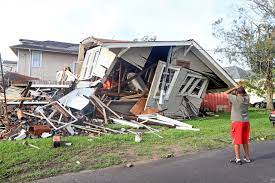The latest data from the World Meteorological Organization (WMO) have estimated that weather, climate and water related disasters drove some US$ 3.64 trillion in losses over the last 50 years, thereby laying bare the high costs of weather disasters around the globe over the decades.
The WMO’s latest Atlas of Mortality and Economic Losses from Weather, Climate and Water Extremes covers the period from 1970 to 2019, during which over 2 million lives were lost to more than 11,000 reported disasters during the period under review.
A news report by artemis.bm, online research firm, indicated that during the period, the research found that weather, climate and water hazards accounted for 50% of all disasters, 45% of all reported deaths and 74% of all reported economic losses, while more than 91% of these deaths occurred in developing countries.
The WMO also reported that its research showed that droughts (650,000 deaths), storms (577,232 deaths), floods (58, 700 deaths) and extreme temperature (55, 736 deaths) drove the highest human impact over the 50-year period.
According to the research findings, on an economic basis the most costly events were storms (US$ 521 billion) and floods (US$ 115 billion) while the 50-year period has seen a significant change in trends, of both incidence of disaster and the impacts from them.
The WMO further believes that the number of disasters has increased by a factor of five over the 50-year period, driven by climate change, more extreme weather and improved reporting, noting that the positive aspect of the research findings is that there has been improved early warning systems and disaster management, the number of deaths decreased almost three-fold over the period.
Specifically, the WMO reported that death tolls fell from over 50,000 deaths in the 1970s to less than 20,000 in the 2010s.
The WMO further stated: “Looking at deaths per day, in the 1970s and 1980s it averaged 170, but by the 1990s, that average fell by one third to 90 related deaths per day, then continued to fall in the 2010s to 40 related deaths per day.
“On the economic side, losses have increased sevenfold from the 1970s to the 2010s. Reported losses from 2010–2019 (US$ 383 million per day on average over the decade) were seven times the amount reported from 1970–1979 (US$ 49 million), the organization clarified.
The organization further reported that storms had been the most prevalent driver of damage and costs, resulting in the largest economic losses around the globe, adding that it is also noteworthy that storms are the only peril for which the attributed portion is continually increasing.
Commenting on the research findings, WMO Secretary-General, Prof. Petteri Taalas, said: “The number of weather, climate and water extremes are increasing and will become more frequent and severe in many parts of the world as a result of climate change
“That means more heatwaves, drought and forest fires such as those we have observed recently in Europe and North America. We have more water vapor in the atmosphere, which is exacerbating extreme rainfall and deadly flooding. The warming of the oceans has affected the frequency and area of existence of the most intense tropical storms.
“Economic losses are mounting as exposure increases. But, behind the stark statistics, lies a message of hope. Improved multi-hazard early warning systems have led to a significant reduction in mortality. Quite simply, we are better than ever before at saving lives”, Taalas added.
Also, Special Representative of the Secretary-General for Disaster Risk Reduction and Head of UNDRR, Mami Mizutori, explained: “More lives are being saved thanks to early warning systems but it is also true that the number of people exposed to disaster risk is increasing due tåo population growth in hazard-exposed areas and the growing intensity and frequency of weather events.
“More international cooperation is needed to tackle the chronic problem of huge numbers of people being displaced each year by floods, storms and drought. We need greater investment in comprehensive disaster risk management ensuring that climate change adaptation is integrated in national and local disaster risk reduction strategies.
“The overlap of the COVID-19 pandemic with many other natural and manmade hazards, especially extreme weather events during the last 18 months demonstrates the need for greater investment in disaster risk reduction and a multi-hazard approach to disaster risk management and early warning systems to reduce risks and strengthen preparedness for multiple disaster scenarios”, Mizutori stressed.
A further analysis of the research findings also reflected that the costliest disasters were all hurricane related and affected the United States, with Katrina leading the way at an estimated economic cost of $163.61 billion while hurricanes Harvey, Irma and Maria from 2017 all feature in the top-ten disaster economic losses as well, along with Sandy and Andrew.
The WMO further stated: “The stunning total figures of US $3.64 trillion of economic losses from weather, climate and water disasters over a 50 year period really drive home the important role of insurance and reinsurance.
“A larger percentage of this figure needs to be covered by insurance and reinsurance capital to enable greater resilience and more rapid recovery when these types of disasters strike.
“Hurricane Ida and the damage caused by Ida’s remnants is another prime example of the important role of insurance and reinsurance in protecting society against weather-related disaster costs”, the organization added.






